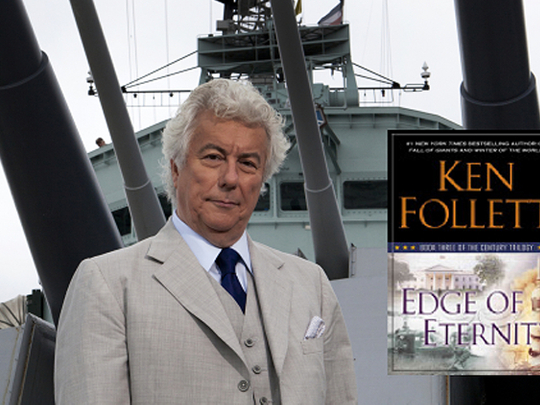
Edge of Eternity
By Ken Follet,
Dutton Adult, 1120 pages, $36
Ken Follet is back — and this time with a mighty tome of 1,004 pages. The latest and final book in his century trilogy, “Edge of Eternity”, was released worldwide on September 16. And like in the first two instalments — “Fall of Giants” in 2010 and “Winter of the World” in 2012 — Follet spins a good yarn.
“Edge of Eternity” takes over where the “Winter of the World” left off. The saga of the five original families — English, American, German, Russian and Welsh (Follet is Welsh, by the way) — is brought to a conclusion here. A trilogy spanning the 20th century, which began with the days and months leading up to the First World War, ends here in living memory, with the fall of the Berlin Wall (the postscript also features US President Barack Obama’s famous speech in Chicago after winning his first term in 2008).
The action in “Edge of Eternity” starts in East Berlin in 1961. The stakes are high this time too, with the Cold War and the dreadfulness of life in East Germany and the Soviet Union; the Cuban missile crisis; America’s disastrous entanglement in the jungles of Vietnam on the one hand and the upheaval of the civil rights movement and a presidential impeachment back home on the other. Add to that the counter-culture of the 1960s.
Rebecca Hoffman is a teacher in East Germany who has to cross over to West Berlin after being spied upon by her own husband, who is a colonel in the East’s pervasive secret police, the Stasi. Tania, the twin sister of Dimka Dvorkin, who is a close aide to Soviet dictator Nikita Khruschev, has carved out as high-flying a career as can be imagined in the USSR, working as a journalist for the state news agency and playing a part in history as she travels from Moscow to Cuba to Prague to Warsaw. Her brother, meanwhile, has a crucial role in defusing the Cuban missile crisis.
In America, George Jakes, the child of a mixed-race couple (whose grandfather Lev fled Russia in Follet’s first book), rejects a career in corporate law to join the Justice Department under Robert F. Kennedy, and influences policy on civil rights whereas Cameron Dewar, grandson of a Senator, finds his calling spying for the CIA.
As before, Follet’s talent lies in the construction of the story and the quality of his research. The author arranges for the paths of his characters to cross effortlessly. And as before, the characters are conveniently close to the heart of the action — Dimka gives the reader an insight into Soviet decision-making by virtue of his proximity to Khruschev while George provides a ringside view of the civil rights struggle and the Kennedy brothers’ less-than-glorious commitment to the cause.
One of the seminal events of the 20th century, however, is missing completely from Follet’s narrative: the Soviet invasion of Afghanistan and the impact the occupation had on the final, ignominious collapse of the USSR. This is especially curious given that Follet is quite an expert on the subject, with the Afghan war being the backdrop for his 1985 bestseller “Lie Down With Lions” (the Sylvester Stallone film “Rambo III” was based on this novel).
Speaking to Weekend Review, Follet said: “I guess I couldn’t see the way to involve my characters in the drama of Afghanistan. It would be quite difficult to send some characters. I suppose I could have had a CIA person there ... it’s difficult to say. I suppose ... you can’t do everything. The book was long enough already and some things just have to be left out. I would have quite liked to include it. It was the last time I think the USSR intervened in a military way in a foreign country.” (See interview on Page 12).
“Edge of Eternity” is meant to be a book that stands on its own; but the interests of the reader are best served if you have read the first two instalments, too.


